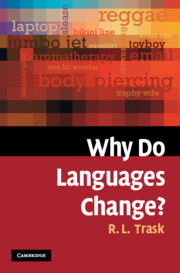Book contents
- Frontmatter
- Contents
- List of figures and tables
- A few words before we start
- Acknowledgements
- 1 How do languages change?
- 2 Why are languages always changing?
- 3 Where do words come from?
- 4 Skunk-Leek – my kind of town: what's in a name?
- 5 Where does English come from?
- 6 Why is American English different from British English?
- 7 Why is English spelling so eccentric?
- 8 Which is the oldest language?
- Some final thoughts
- Further reading
- Index
6 - Why is American English different from British English?
Published online by Cambridge University Press: 05 June 2012
- Frontmatter
- Contents
- List of figures and tables
- A few words before we start
- Acknowledgements
- 1 How do languages change?
- 2 Why are languages always changing?
- 3 Where do words come from?
- 4 Skunk-Leek – my kind of town: what's in a name?
- 5 Where does English come from?
- 6 Why is American English different from British English?
- 7 Why is English spelling so eccentric?
- 8 Which is the oldest language?
- Some final thoughts
- Further reading
- Index
Summary
In the early seventeenth century, the first English-speaking colonists settled in North America, first in Virginia, then in Massachusetts, and before long along the entire east coast. Reinforced by a steady flow of English speakers from all parts of England and Wales and later also of Scotland and Ireland, these settlements guaranteed that English would be the principal language of the little colonies which would eventually grow into the United States of America, the largest English-speaking nation in the world. Today more than half of all native speakers of English are American citizens.
Those early settlers of North America took with them the same English they had spoken at home. Yet today the differences between British and American English are numerous and prominent. There are differences in pronunciation. To an American, fertile rhymes perfectly with turtle, while to a Briton these words do not sound even vaguely similar. And, to an Englishman, a klahk is a person who performs routine paperwork in an office, while to an American a klahk is a machine that tells you what time it is. There are differences in spelling: British colour and American color; British civilise and American civilize; British theatre and American theater; and many others. There are differences in vocabulary. The season after summer is autumn in Britain but fall in the States, and the thing you turn to get water is a tap in Britain but a faucet in the States. There are differences in word meaning.
- Type
- Chapter
- Information
- Why Do Languages Change? , pp. 106 - 129Publisher: Cambridge University PressPrint publication year: 2009



